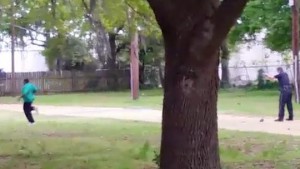Walter Scott’s Death Should Bring Progress and a Reminder of the Importance of Filming Police Misconduct
Walter Scott’s death was the result of a traffic stop that went terribly wrong. A white North Charleston police officer, Michael Slager, shot Walter Scott, an African American, eight times in the back, as Scott ran away, following a traffic stop for a broken tail light. A video shot by a bystander clearly shows that Slager was not in immediate danger. Despite the fact that the Supreme Court ruled in 1985 that it is illegal to shoot a suspect in the back unless there is “reasonable fear of danger to the police officer or the public,” Slager shot Scott in the back anyway.
The officer involved in the shooting was obviously aware of the law, evident by the fact that he stated he “felt threatened” before shooting Scott and that Scott “took my Taser.” Even though the video clearly shows that no CPR was performed until paramedics arrived, the police report falsely states that the officers at the scene performed CPR on Scott. If these blatant lies by Slager are not shocking enough, the video also shows Slager initially walking over to Scott, running back to his firing spot, picking up his Taser, and finally walking 25-30 feet back and dropping it next to Scott’s lifeless body.
Although police misconduct has been a reality for many years, it wasn’t until the brutal beating of Rodney King in1992 that it was brought to national attention. The acquittal of the police officers involved in the beating resulted in riots throughout the City. The similarity between the two cases is that both were caught on film.
Scott’s case stands out among the recent cases of police misconduct, involving the murders of Michael Brown and Eric Garner. Although their deaths resulted in unprecedented national-protests, neither one of the officers involved were indicted for murder. However, the Walter Scott case stands out because Slager was arrested, indicted and charged with Scott’s murder.
Scott’s slaying is likely to provide a similar rallying point for civil rights activists who highlight that the acts of excessive police brutality are targeted largely towards men of color. It is important to note that while both Scott and King have video documentation of the incidents, Eric Garner’s death, caused by a chokehold which was banned by the New York City police department, was also videotaped but did not result in a grand jury indictment of the officer.
The videotaping of police misconduct has been a subject of controversy, as well as the implications of police retaliation against those who film the events. For example, a reporter was detained and assaulted by police officers while attempting to film a protest in the town where Michael Brown was killed by a white police officer. Similarly, in the Garner case, a grand jury did bring an indictment against the man who filmed the incident, allegedly on weapons charges. However, these charges were curiously brought soon after the filming of Garner’s death. Other instances of retaliation have occurred, despite the fact that these filming’s are currently legal.
Police officers are rarely charged for excessive force. Research from Bowling Green State University shows that only 41 officers were charged with murder or manslaughter, in comparison to FBI data that there were 2,781 justified homicides by police in the same time period. The data was collected over a seven year period ending in 2011. Along with these staggering numbers, many legal issues have arisen when it comes to citizens recording the actions of police.
Twelve states currently have a law known as a “two party consent”, including California, Connecticut, Delaware, Florida, Massachusetts, Maryland, Michigan, Montana, New Hampshire, Pennsylvania and Washington. In these states, both parties must know and consent to a recording. However, the laws were initially enacted to protect one’s privacy during a phone call and the Supreme Court has yet to rule that the police have a “reasonable expectation of privacy.”
Nonetheless, due to the increases number of videos documenting police brutality, some states are seeking to place restrictions on private citizens recording the actions of the police. For example, in Texas, a bill has been introduced to make it illegal to tape the police within 25 feet. There are even Texas legislators that are attempting to amend the bill to make it a misdemeanor to film the police at all.
It is important for citizens to know their rights if they have the unfortunate experience of witnessing a shooting, or other forms of brutality, by a police officer.
- There is right to photograph or videotape any actions that are in plain view if those actions take place in a public space.
- Unless the police have a warrant, they may not confiscate, or even demand, that a person turn over a photograph or video. Likewise they may not delete anything from a digital video or photograph.
- If the police feel that a person’s activities are interfering with their ability to perform their job, it is legal for the police to order a person to stop an activity. Therefore, it is important to take pictures and videos far enough away, as to not get caught in the middle of a physical altercation with the police and the alleged suspect.
Without the video of the murder of Walter Scott, at the hands of a white police officer, the story would turned out much differently. Slager likely would not have been indicted and Scott’s name would have been smeared in the media to justify the shooting, as was the case with Garner and Brown. Hopefully, the murder of Scott will result in police accountability and reduce the number of men of color assaulted and killed by the very officers whose job it is to protect and serve.



Comments